Egg Tempera
An Introduction to Painting with Egg Tempera
in Susan G. Scott’s Hidden Children Series
THE HIDDEN CHILDREN series
by Christine Unger
Between 2021 and 2022, Susan G. Scott painted the series of small panels in egg tempera that make up The Hidden Children series. These small panels present imagined moments in the stories of children who have been forced to hide during times of social and political upheaval and uncertainty, living in fear and isolation.
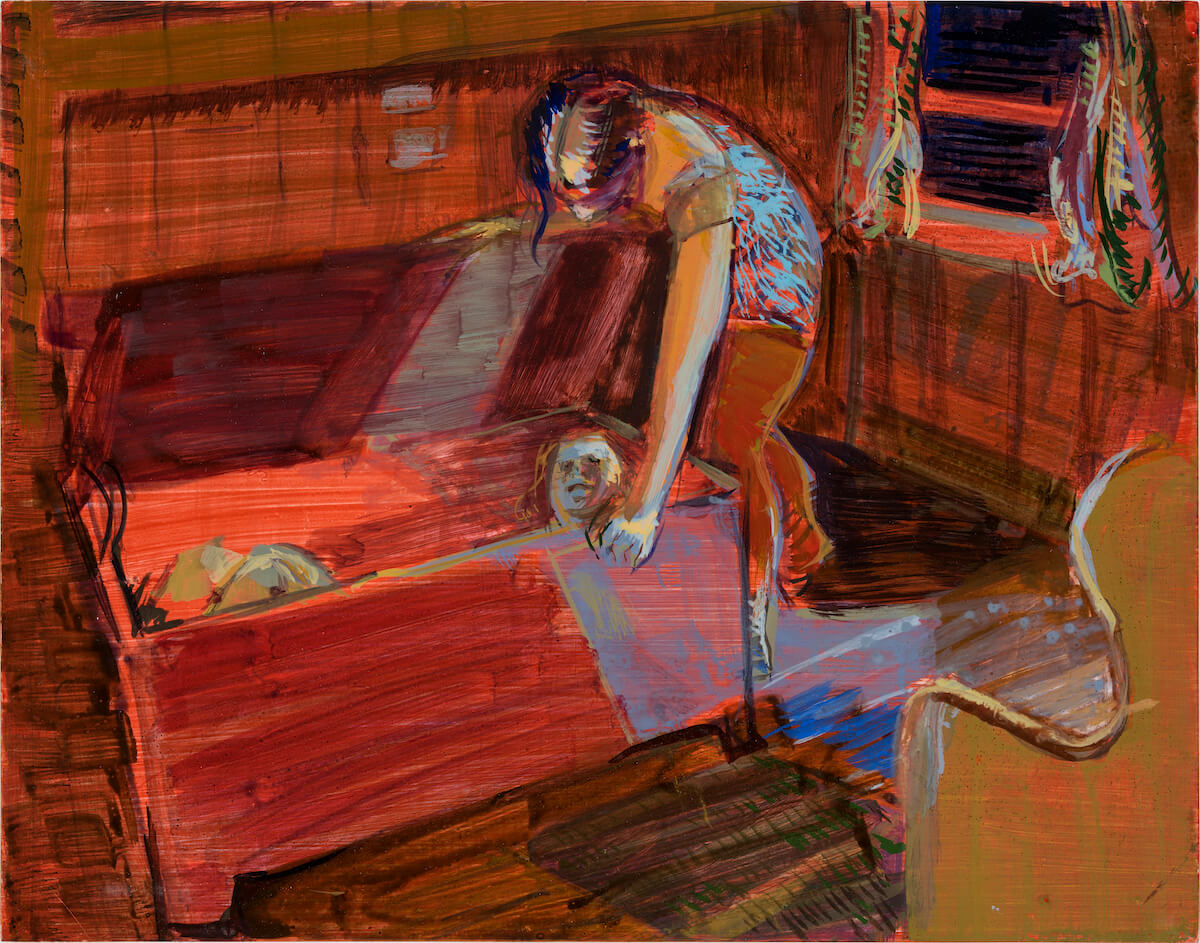
RED BOX, 2022, egg tempera on panel, 11 x 14 inches / 28 x 35.5 cm, catalogue # 22E10
“During the height of the COVID 19 pandemic, Scott, in her 70’s found herself cut off from friends and family for long periods. Almost daily, she would see articles on the physical and emotional consequences of social distancing, particularly for children. She had grown up haunted by the first hand stories told by friends and relatives, of children who had been secreted away during the period of the Second World War, in attics, forests, sewers, basements, wherever they could shelter unseen. Throughout Europe, Fascists, using the pseudo-science of Eugenics as a justification, swept up millions of people, taking them to work camps and death camps. They took mentally and physically disadvantaged people, peoples of Jewish and Gypsy heritage, in fact, any peoples who were “inconvenient” to their cause. Those who could, fled, but many, lacking time, resources, or opportunity, hid or were hidden. Many of these people were children.
Because they are still developing, children were for centuries without status before the law, often considered little more than property. Even in the developed world they are vulnerable, with mos of their rights secondary to the wishes and actions of the adults who meant to care for them. Attempts were made to create an international standard for the treatment of children as early as 1919 following the first world war when activist Eglantyne Jebb, advocating for the special Rights of Children, stated that, “All wars are waged against children.” promulgating the Declaration of Child Rights which eventually resulted in the League of Nations’ adoption in 1924 of the Geneva Declaration of the “Rights of the Child”
“the original 1924 Declaration was based on ideas of child welfare, rather than child rights, assuming that children require adult protection in order to ensure the exercise of their rights. These ideas persisted through the re-drafting of the Declaration during the lifetime of the League of Nations, as well as in the 1959 UN Declaration of the Rights of the Child. Thus children continued to be seen as objects of international human rights law and not as subjects of rights.:” (The History of Children’s Rights: Whose Story? Cultural Survival, 2010)
In recent years, events and conflicts around the world have highlighted how easily the rights and needs of children are put aside in the pursuit of social and political agendas, how often they are, in fact, used to fulfill social agendas. The objectification of children is a continuing source of injustice worldwide, perpetuating situations in which children are subject to laws and conditions without being given a voice. They are effectively “hidden,” – “seen and not heard,”
The small, vibrant paintings of Susan G. Scott’s “Hidden Children” series, give a sense of both intimacy and urgency. Often set at night, the paintings are both poignant and haunting, evoking the sense of separation and anxiety that these children must have experienced during their time in hiding. At times though, there is also a sense of determination, of the need for play and exploration that provide a sense of hope as well.
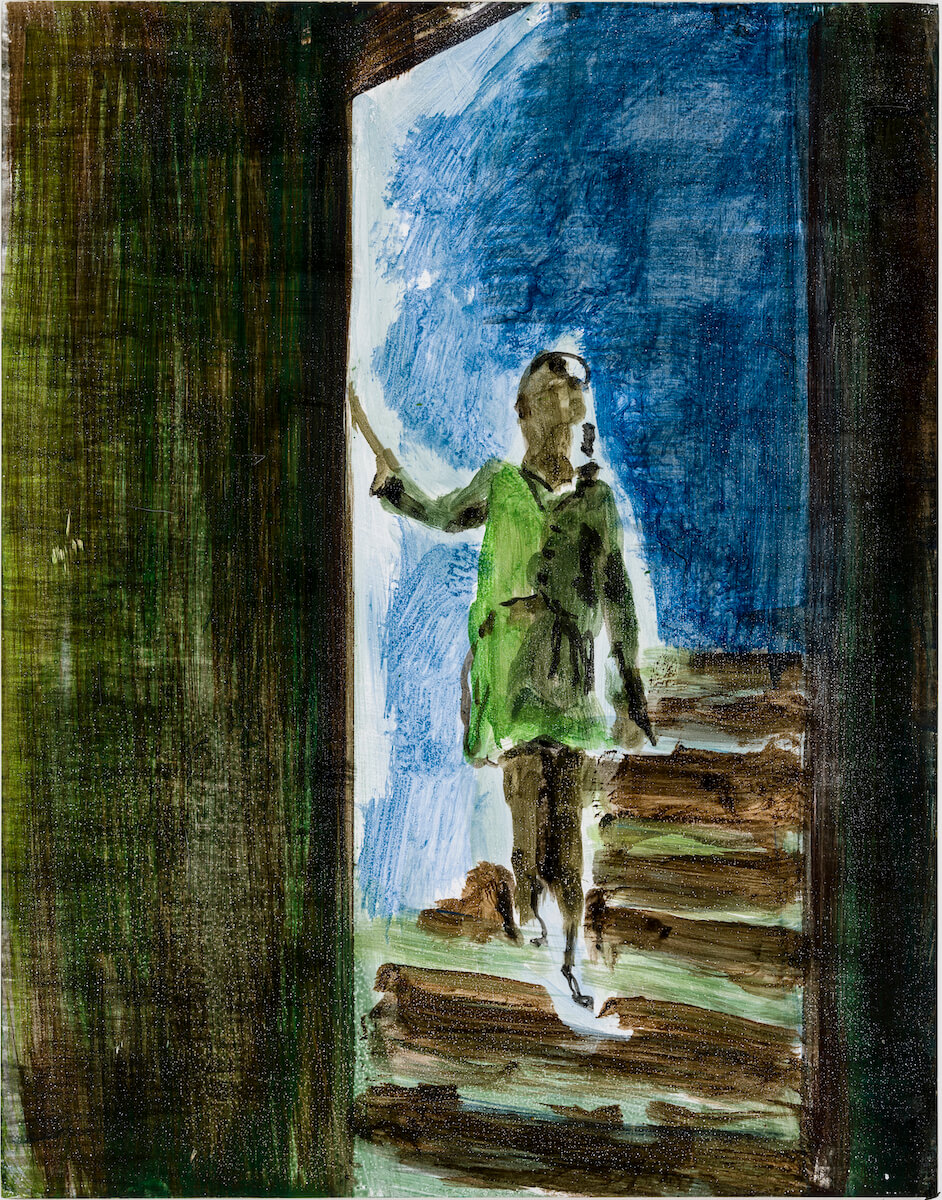
DESCENT, 2022
egg tempera on panel, 14 x 11 inches / 35.56 x 27.94 cm, catalogue # 22E11
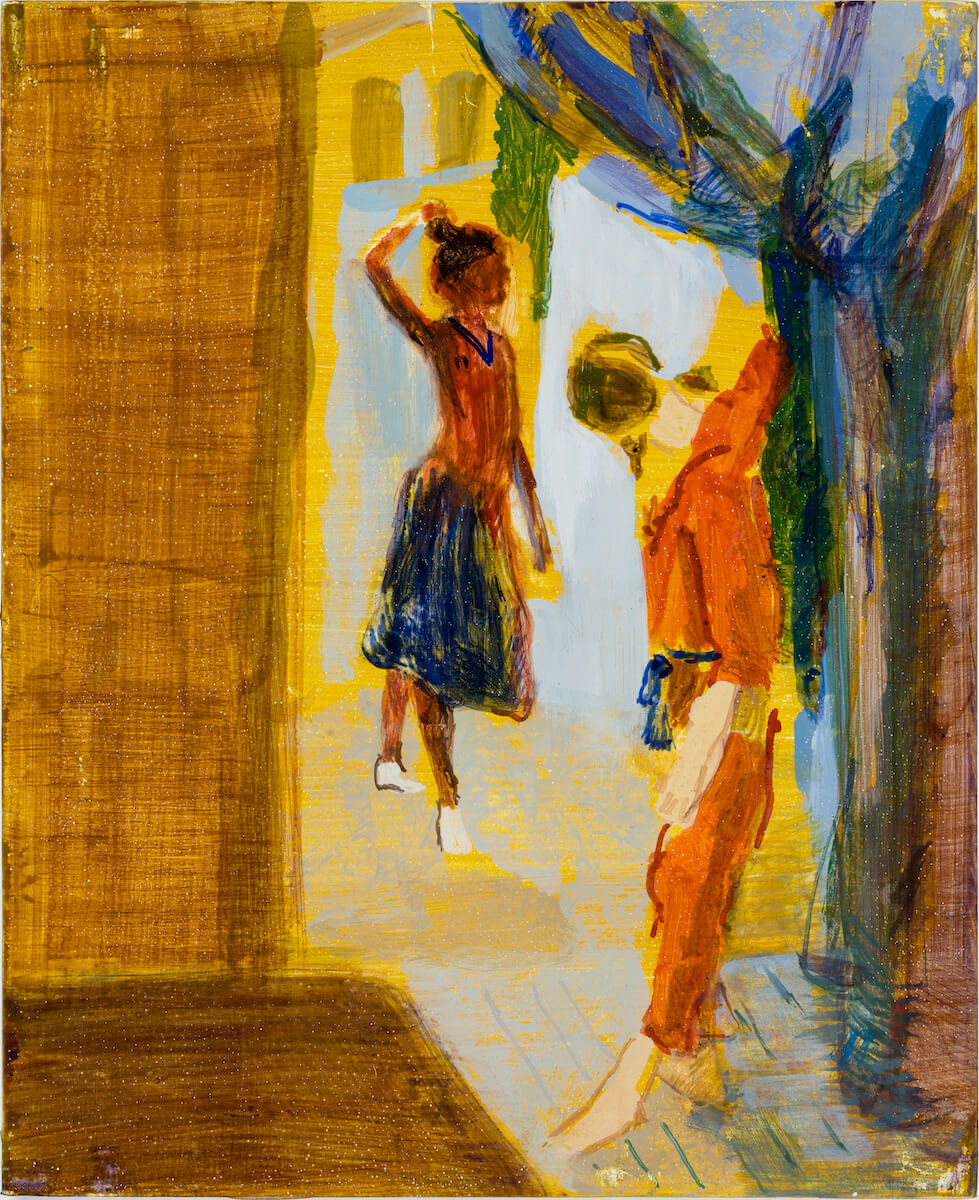
DRESS-UP, 2022
egg oil on tempera, 11 x 9 inches / 27.94 x 22.86 cm, catalogue # 22E17
Talking about the series, Scott noted that,
“The idea of being hidden away, not being able to engage in normal social activities, struck a chord with me. I wanted to explore that feeling of isolation and uncertainty, and to draw attention to the resilience of these hidden children who were able to survive such difficult circumstances.”
The Hidden Children series began with Scott creating a succession of watercolour sketches in 2009. Throughout her early years as a mother she often reflected on the stories she had heard from friends, acquaintances, and family who had themselves been hidden as children, kept safe from the camps during World War II. She couldn’t help but imagine what her own children’s lives might have been like had her family lived in Europe during the war.
She spent her early career creating figurative-narrative series, often involving children. During this period she would frequently turn for inspiration to the endlessly inventive, playful, and even humorous works by the artist Charlotte Salomon. Salomon created 1,700 autobiographical paintings and text-overlaid transparencies,1 749 of which are collected in the work: Life? or Theater? (Leben? oder Theater?). They were created while she was an art student in Germany and later, while hiding away in France from the Nazis, before she was captured and killed in the concentration camp, Auschwitz, in 1943 at the age of 26.
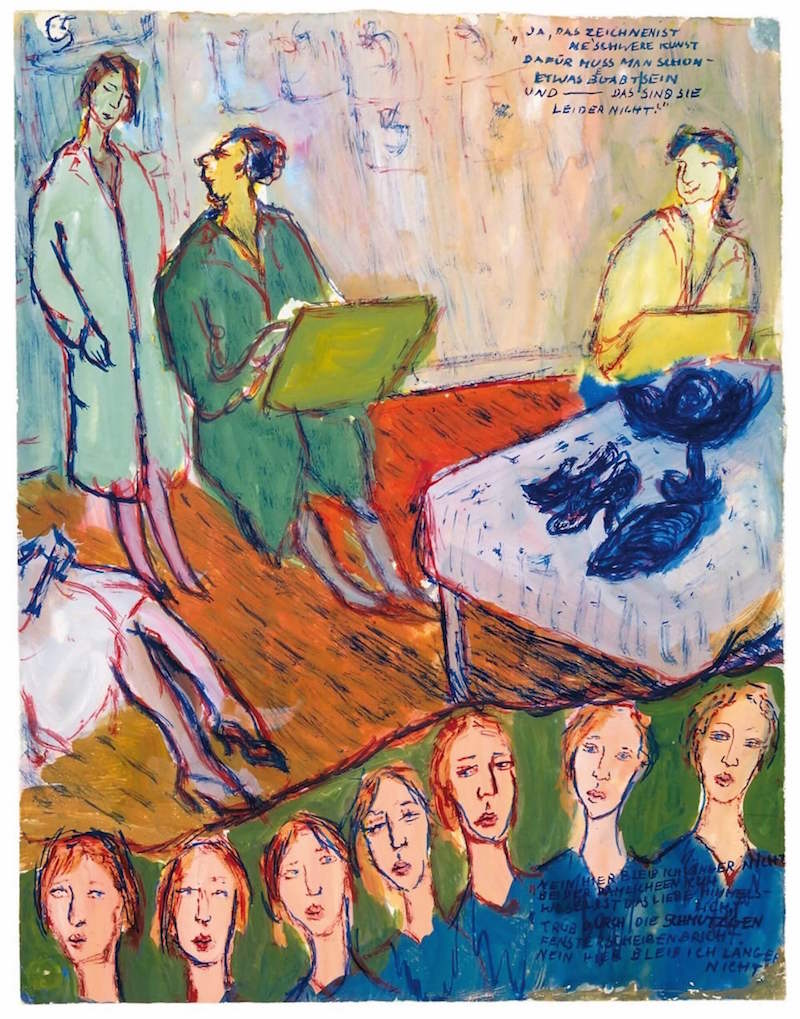
A page from Life? or Theater? (Leben? oder Theater?) by Charlotte Salomon – Charlotte’s conflict with her drawing teacher | © Charlotte Salomon Foundation, Amsterdam.
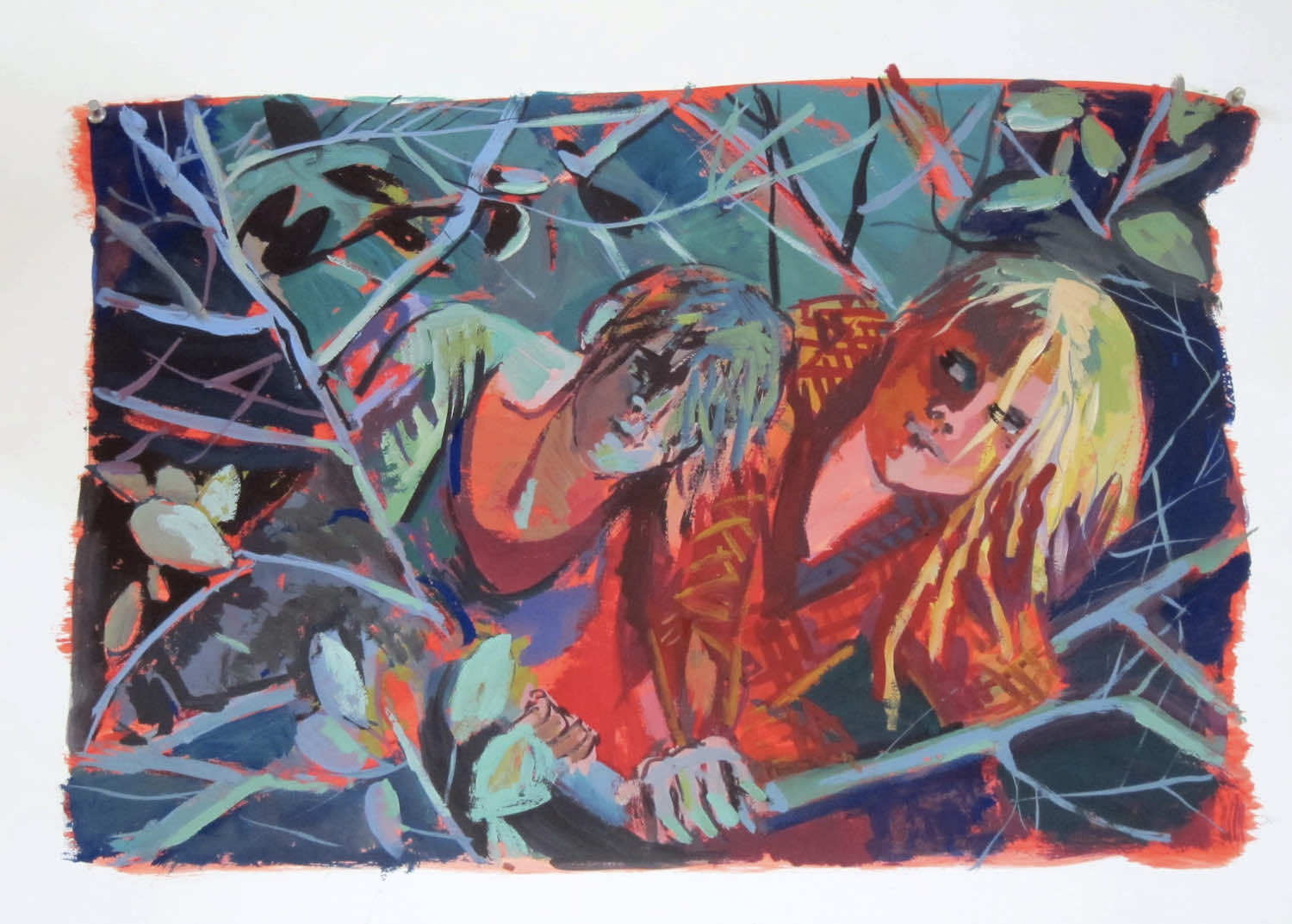
Susan G. Scott, Hidden Children sketch, 2009
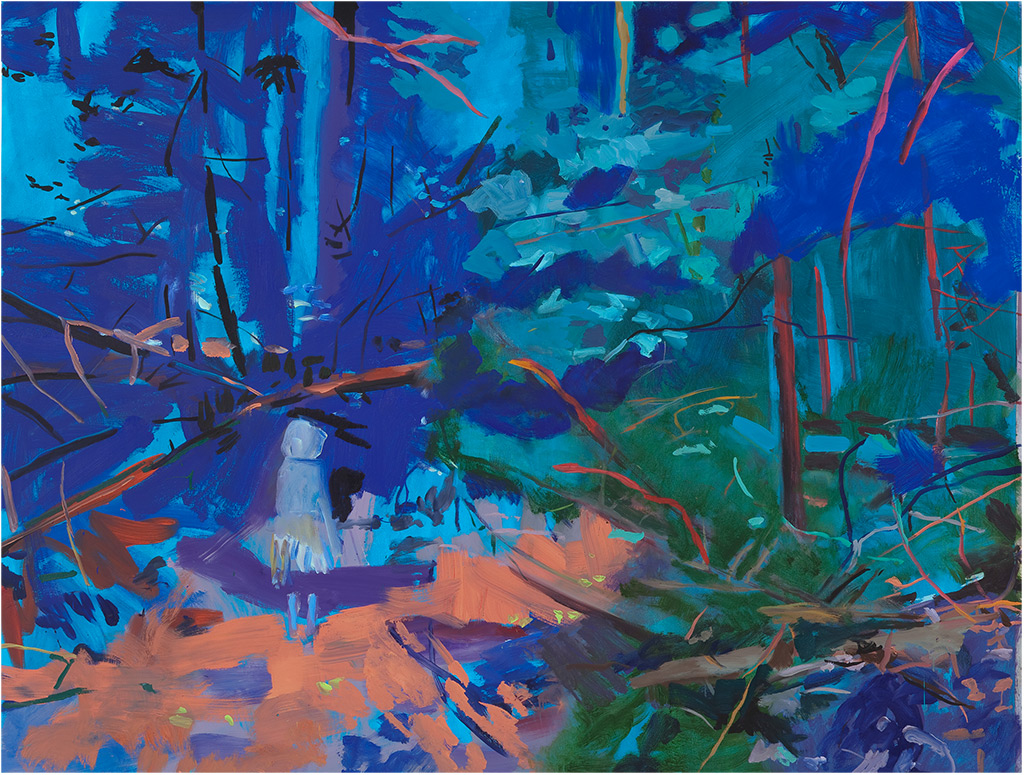
Susan G. Scott, Night Incomplete, 2011, 49 in. x 67 1/2 in. oil on canvas, catalogue # 11d01
Although the figures of children, playing within the woodland, almost concealed, still remained, by 2009 Scott was already moving her subject matter towards landscape. Although she considered developing the ‘hidden’ children sketches into a series of oil paintings she instead dedicated her work to landscapes. As seen in the short documentary “Thousands of Tiny Footsteps” directed by Nasuna Stuart-Ulin, the woodland stream that runs next to her summer studio in Vermont, became her primary focus.
It was during the pandemic, through the long months of lock-downs in 2020 and 2021, that she began to contemplate the “Hidden Children” sketches once more. With daily reports on the consequences of children living in isolation from their classmates, friends and older family members, suffering depression and learning and social deficits, she began, once more, to contemplate just how difficult the lives of the children hidden away because of war or social upheaval must be: how vulnerable these fragile little people are and yet how strong they have to be to endure. The horrifying revelations of the atrocities perpetrated in Canada’s own Residential School system intensified a sense of urgency, magnifying the truth of how easily society turns away from the those who are helpless and least able to voice their issues, how quickly we choose to forget the past.
Pandemic lock-downs offered time and licence for many people to share their stories on social media: communally taking long over-due stock of social inequities between the genders, racialized minorities, migrants and immigrants, the physically disadvantaged, and religious minorities. Yet some of the greatest injustices of human history were, against all odds, being forgotten or worse, purposely misremembered, opening an ethical gateway for such atrocities to be repeated. She determined that her series “Hidden Children” could play a small part in bringing these stories back into focus.
HIDDEN CHILDREN SKETCHES 2009
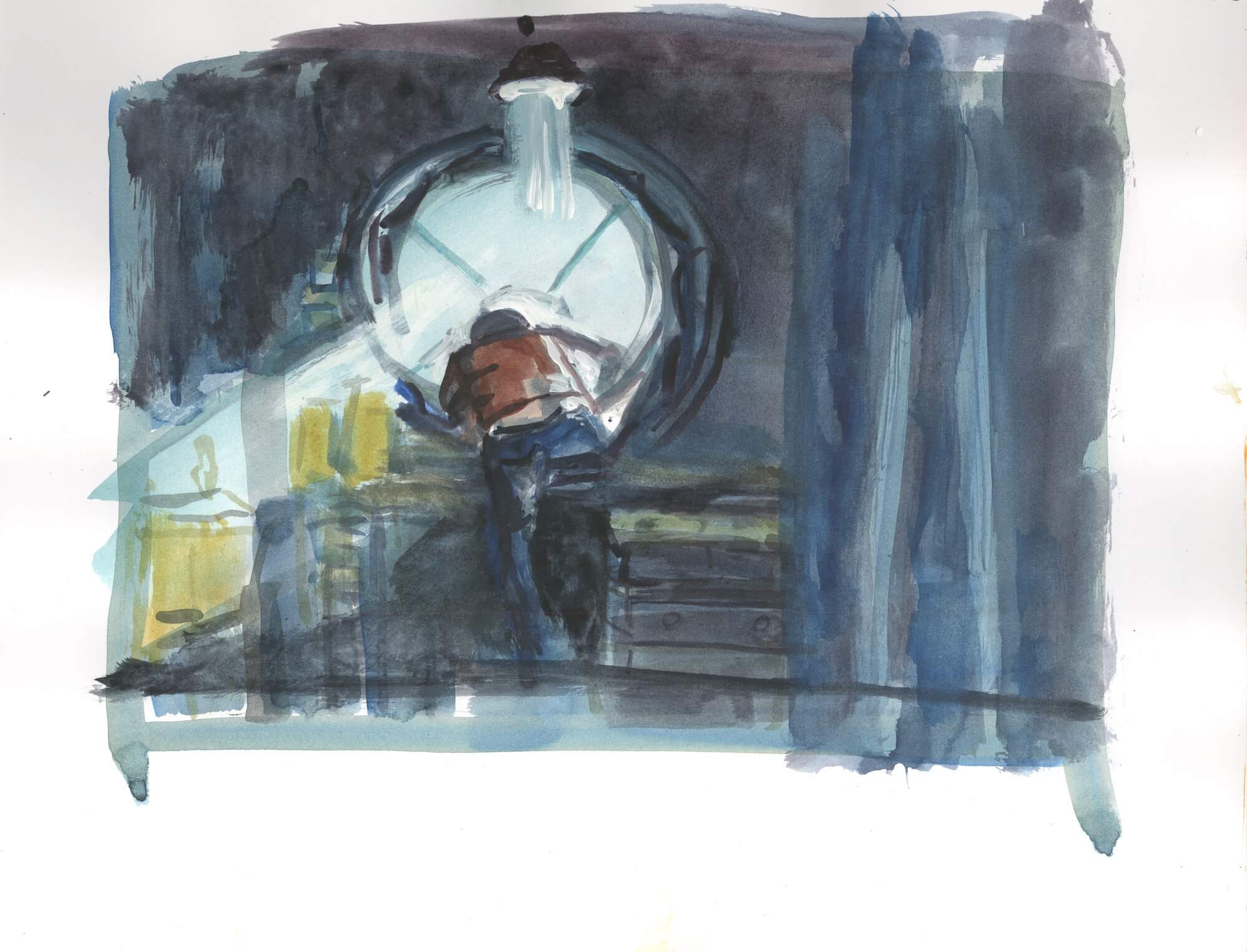
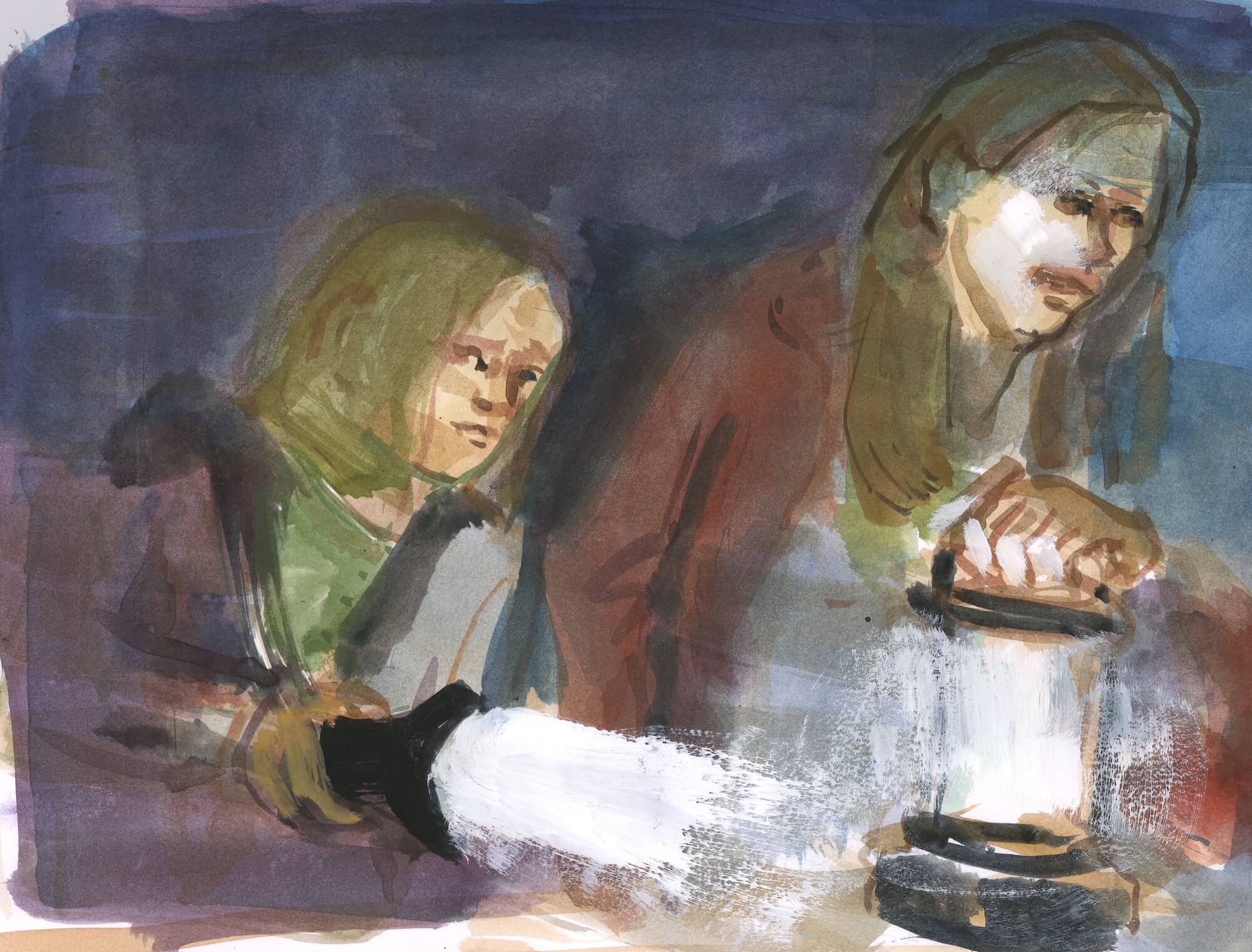
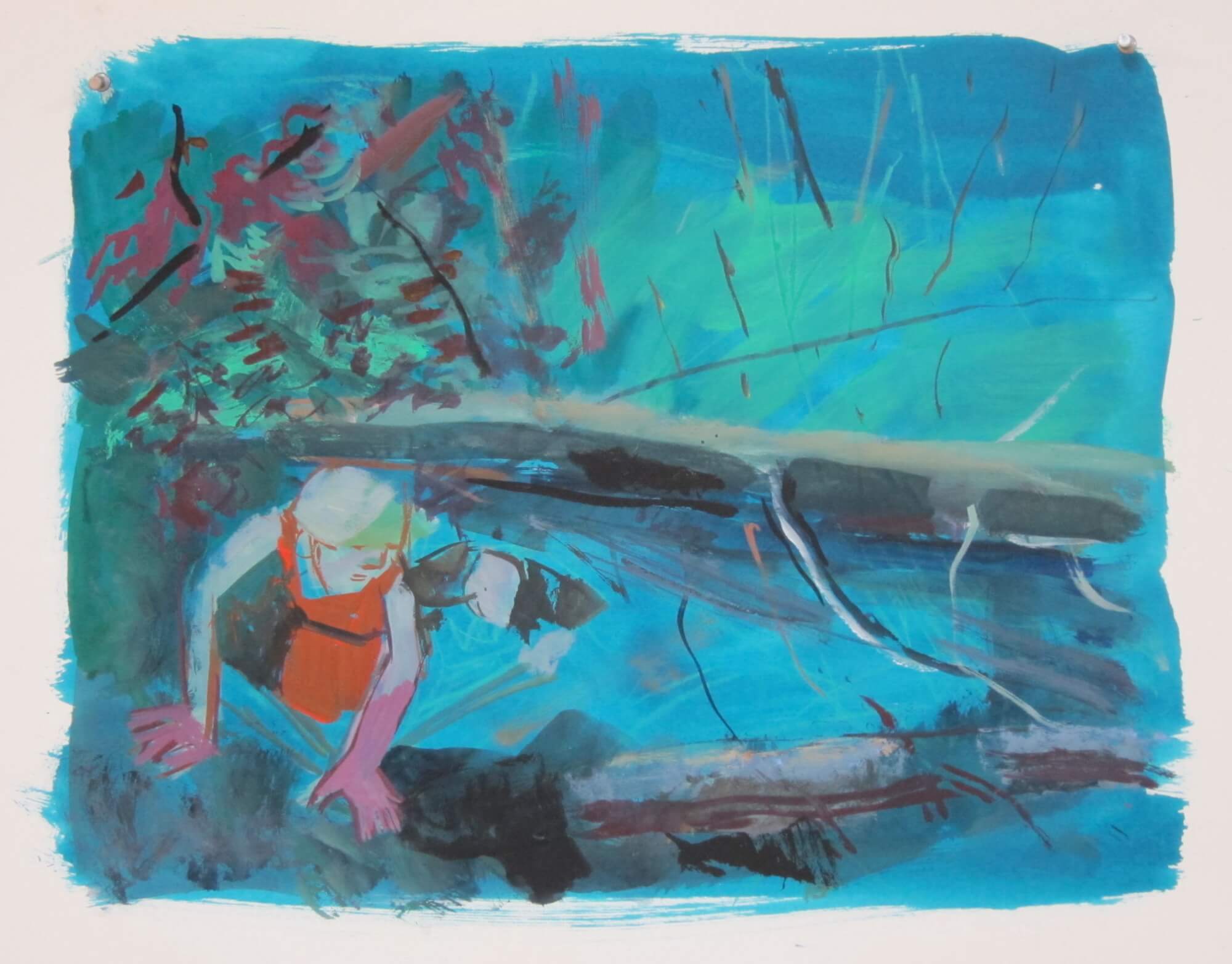
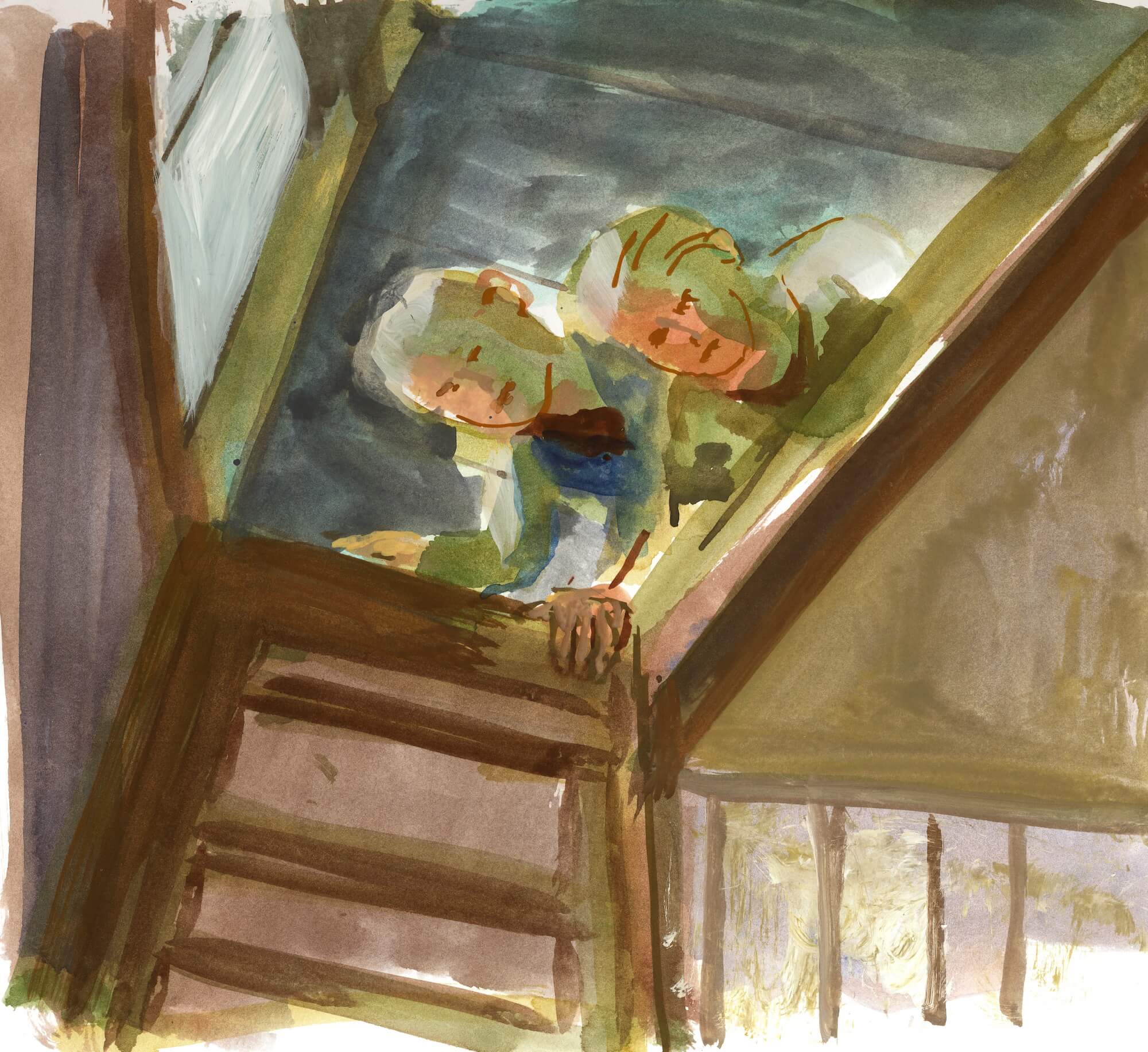
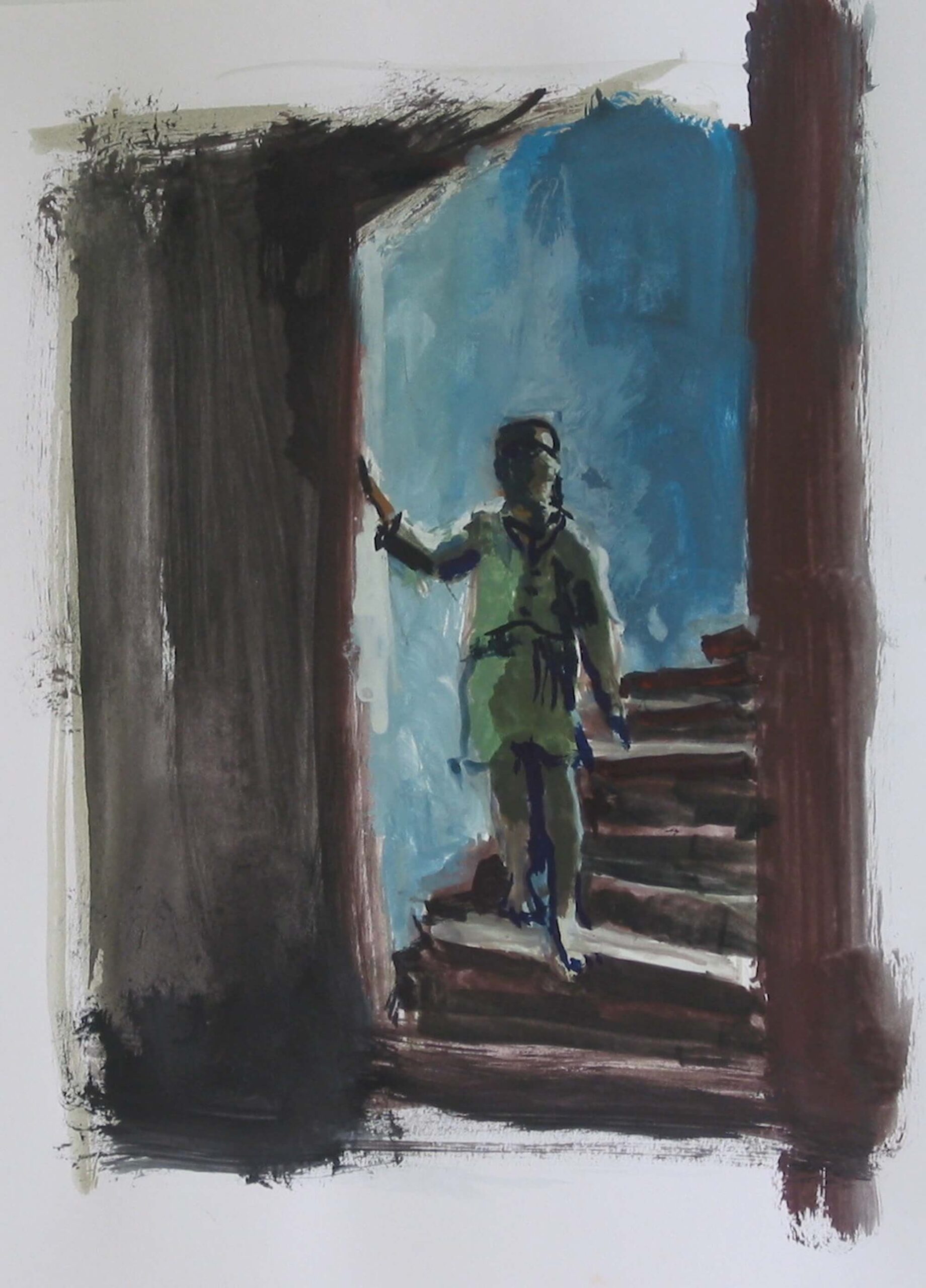
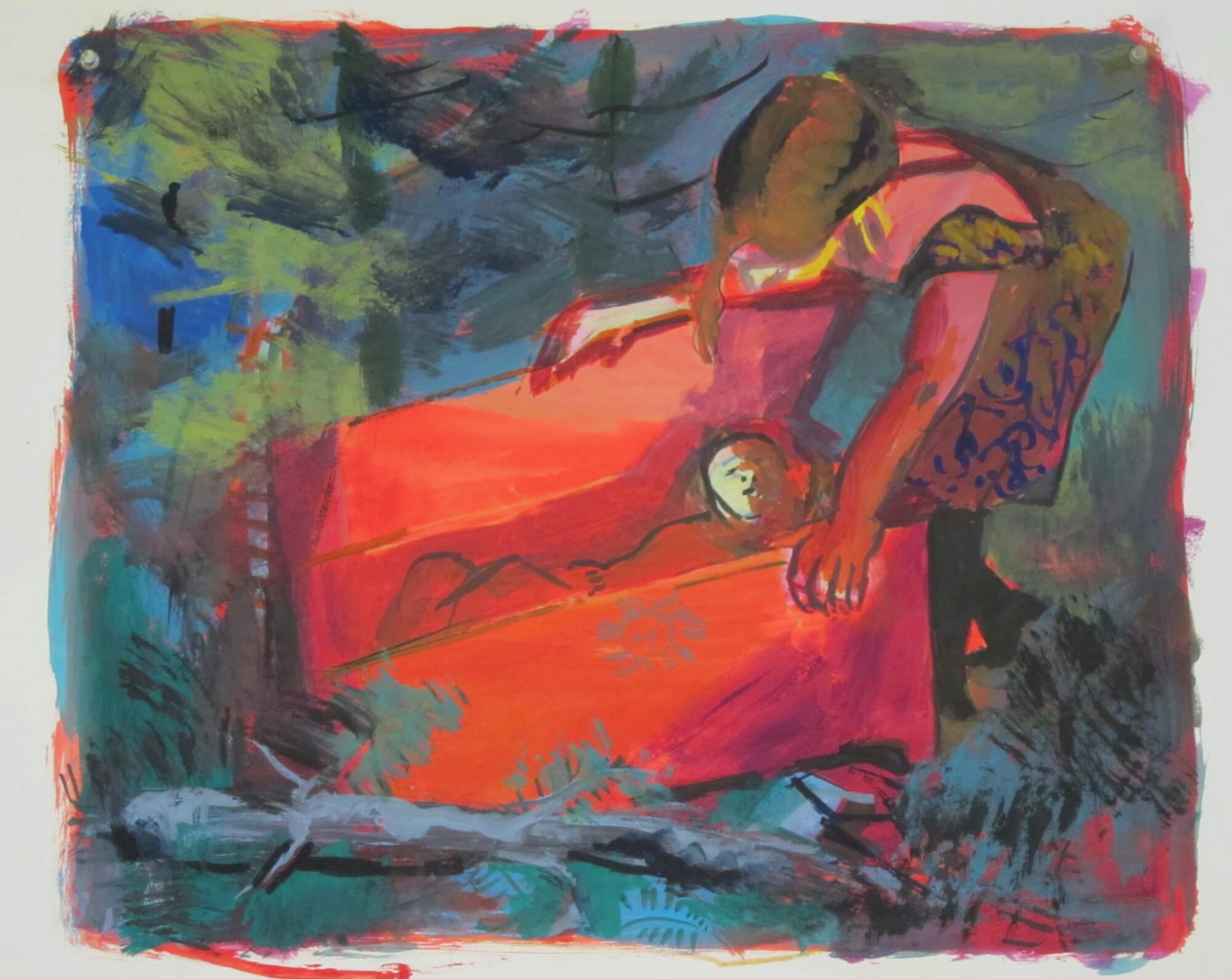
In using egg tempera to create “Hidden Children,” Scott is both paying homage to the tradition of this medium and using it to explore contemporary issues in a meaningful way. Her paintings remind us of the importance of remembering and honouring the experiences of the countless children who have been hidden away, throughout history, their lives, their education, their emotional, social and even physical development, scarred, often permanently. Through her use of egg tempera, Scott is able to create paintings that are both timeless and timely, and that speak to the enduring power of art to evoke emotion and inspire empathy.
Methods and Materials in the Hidden Children series
Scott has had a long standing fascination with historical methods and materials. She considers using alternative mediums, methods or techniques to be an invaluable avenue to finding new perspectives for one’s subject matter. At Concordia University in Montréal (Québec, Canada) where she has taught since 1984, she created a course called “Methods and Materials.” She teaches her students to explore the potentials of alternative mediums including encaustic, fresco and egg tempera, to her students. She began teaching the use of egg tempera in 2020 which she first taught herself using Altoon Sultan’s book, “The Luminous Brush”2
Historical methods and materials can help both artist and audience relate to alternative time frames, opening up different ways of thinking, and providing a sense of interconnection with the past and the future. Scott has demonstrated this in numerous series, as she did with her 1999 series “Fragments.” Greenish tones of aged copper and a combination of oil, acrylic and pumice create a gritty finish reminiscent of aged surfaces, evoking a sense of the inevitability of time’s passage.
Scott, like communication theorist Marshall McLuhan, believes, at least in part, that “the medium is the message,” conveying a great deal to the viewer about the subject matter.
The panels of Hidden Children are small, yet strong, just as their subjects are. Egg tempera, aside from its luminous quality, references iconographic significance of its subject matter and the enduring vibrancy of its subjects. The use of egg speaks to the fragile nature of childhood, and the encapsulation of potential.
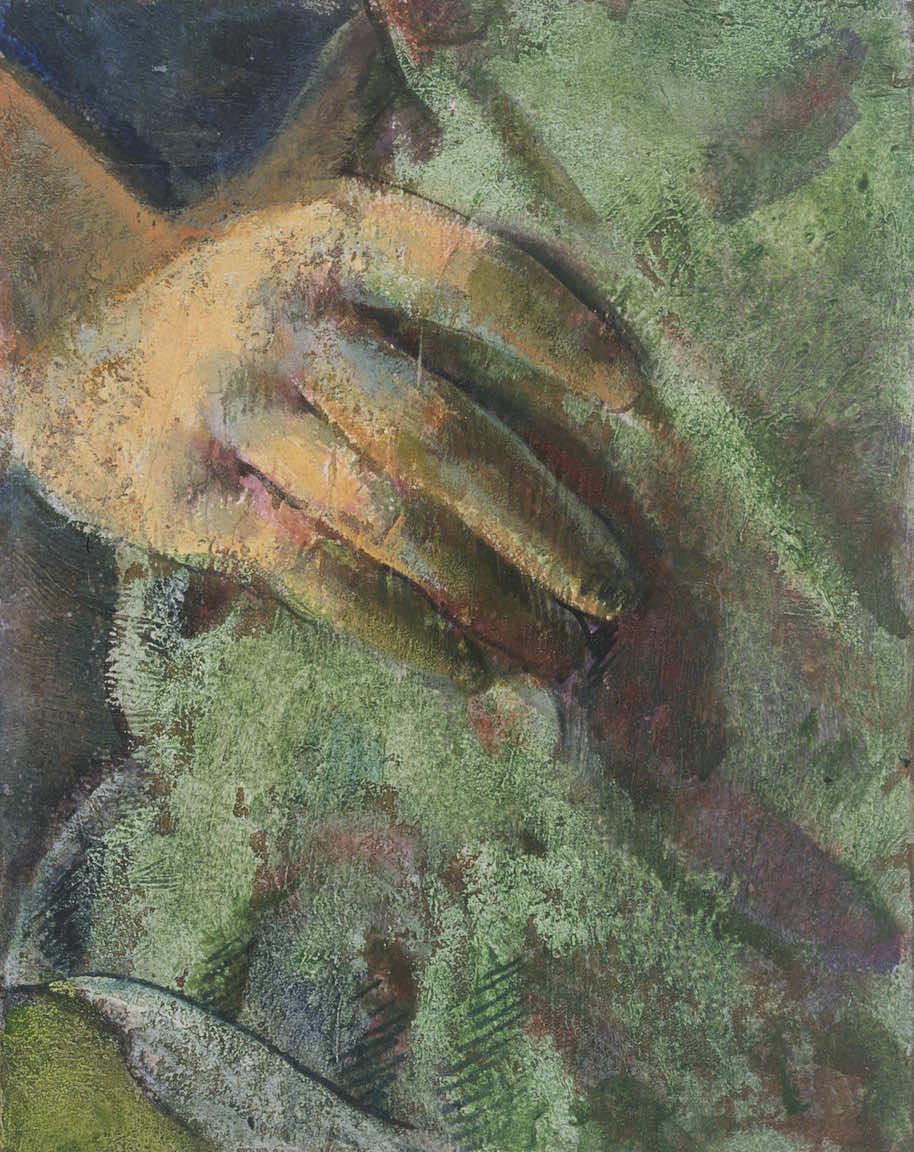
Susan G. Scott, Fragment # 1, 1999
oil, acrylic and pumice on canvas, 14 in. x 11 in. (27.94 x 35.56 cm) catalogue # 99D01 – PRIVATE COLLECTION
Implementing negative space in new mediums
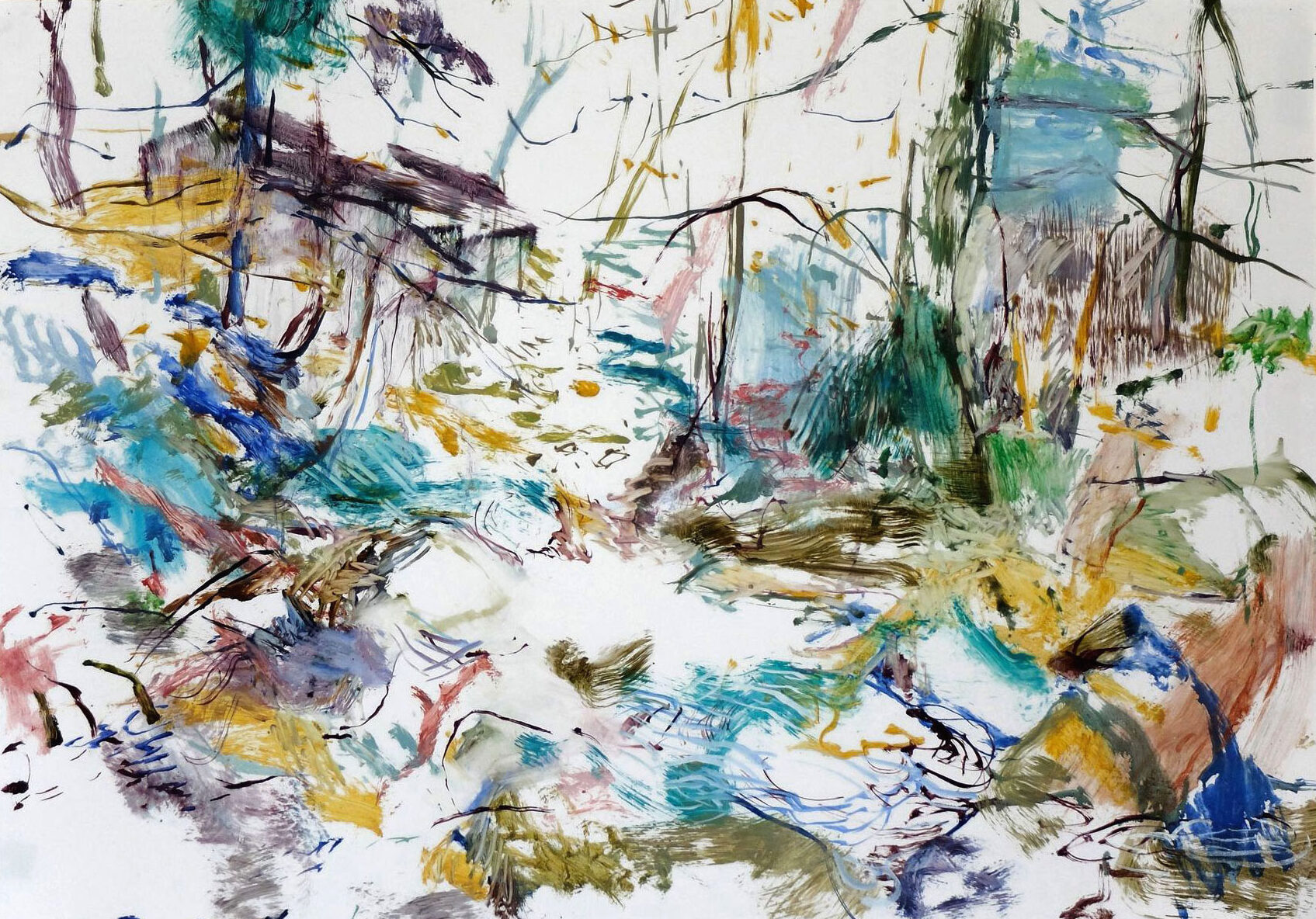
Susan G. Scott, Waters no. 17
28 x 40 inches (71 x 102 cm), oil on terraskin, 2013. – catalogue # 13T32
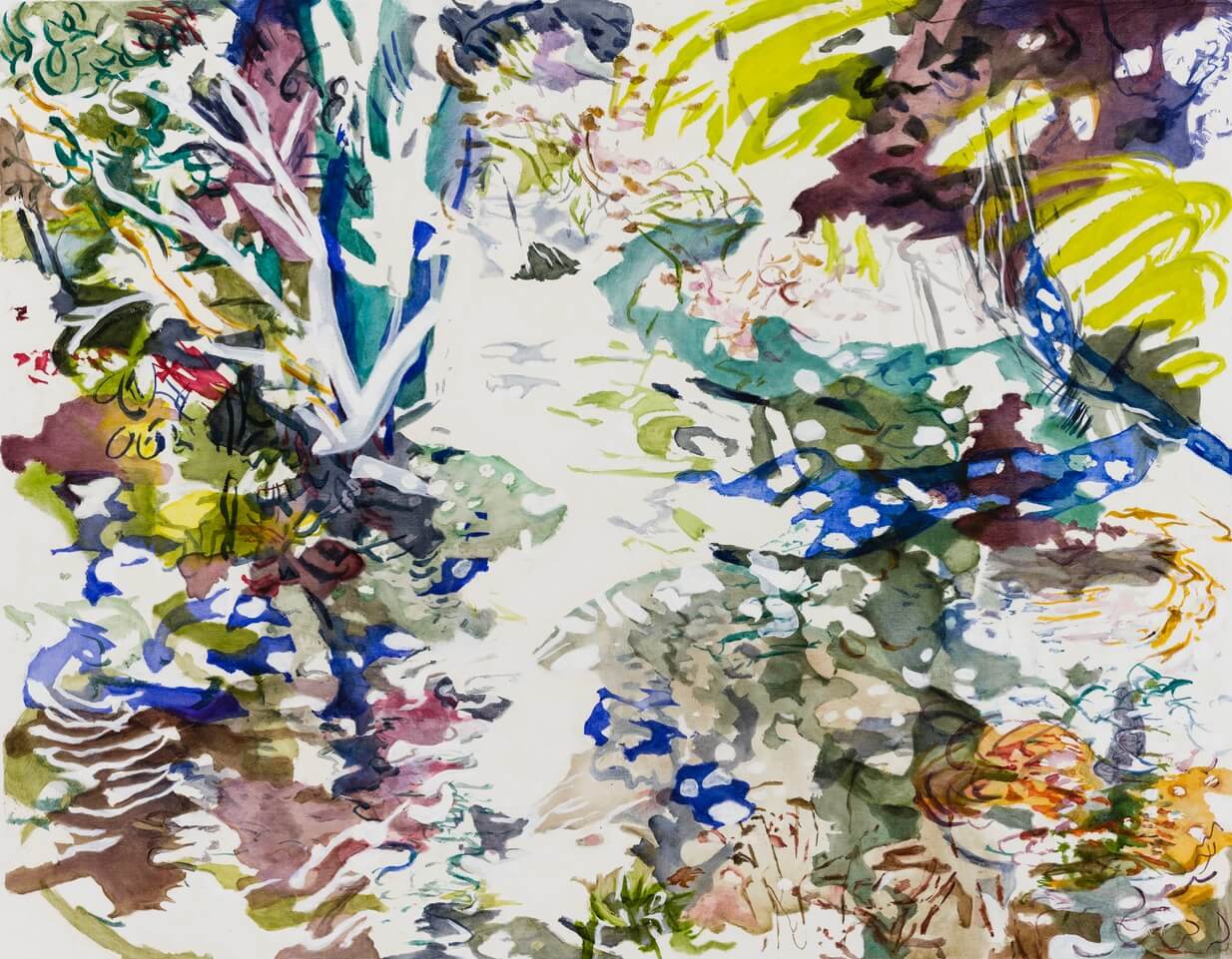
Susan G. Scott, Ripples Like Wings, 2021, oil on canvas, 40 x 50 inches / 101.6 x 127 cm
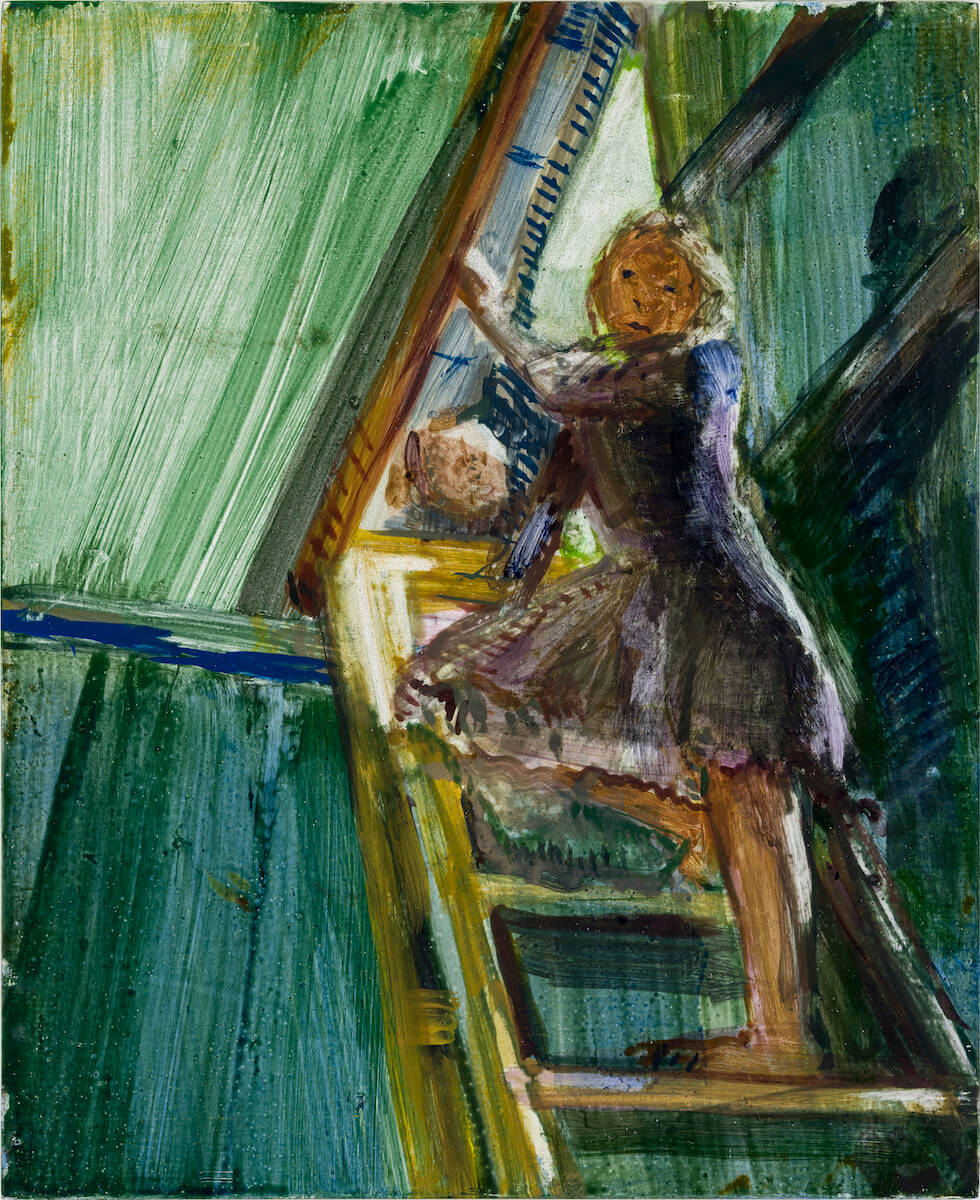
Susan G. Scott, DOWN, 2022, egg tempera on panel, 11 x 9 inches / 27.94 x 22.86 cm, catalogue # 22E13
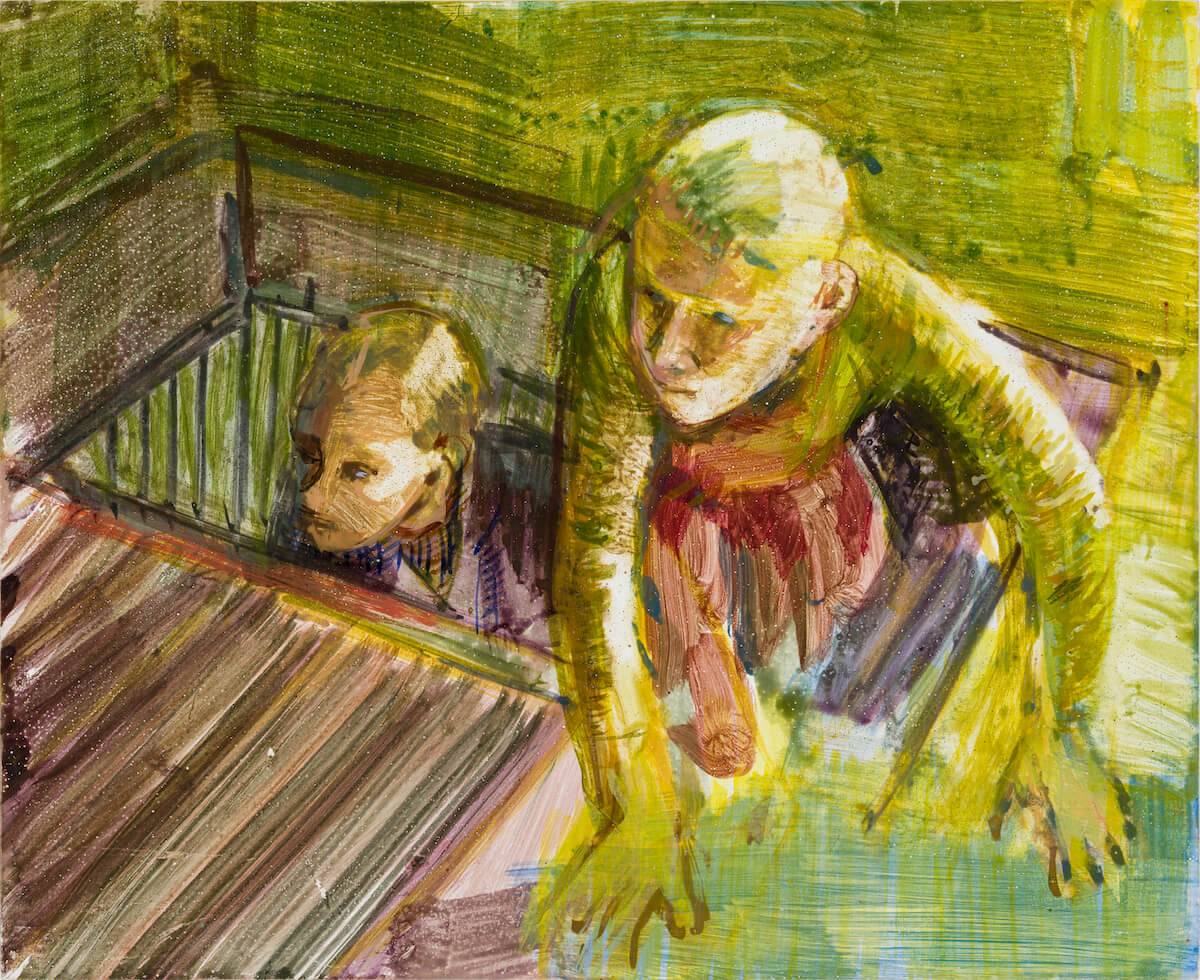
Susan G. Scott, ATTIC, 2022, egg tempera on panel, 9 x 11 inches / 22.86 x 27.94 cm
SUSAN G. SCOTT
on the techniques used specifically for the Hidden Children series
I found that, instead of using the traditional egg tempera technique with a monochromatic ink underpainting as I had taught my students, I was more drawn to using egg tempera in the same way I use watercolour: using a white ground as light and sometimes using a coloured imprimatura.
I discovered early in my experimentation that unlike watercolour, the paint is reversible. I can be ‘erased,’ pulled off, to return to the white ground — if I was working in the same session.
As the most recent series of oil paintings that I’ve worked on in my studio are based on watercolours and look very much like watercolours I had developed a process of working with resist which I discovered could be achieved quite easily with the egg tempera works. The small panels are maintaining the same kind of thinking process that I am using in my large oil paintings.
The Egg Tempera recipe used for Hidden Children:
Egg yolk
Dry pigment
1) Grind the pigment with a glass muller while adding water and alcohol.
2) Then use small amounts of this mixture with egg yolk, mixed (as needed) to create different colours.
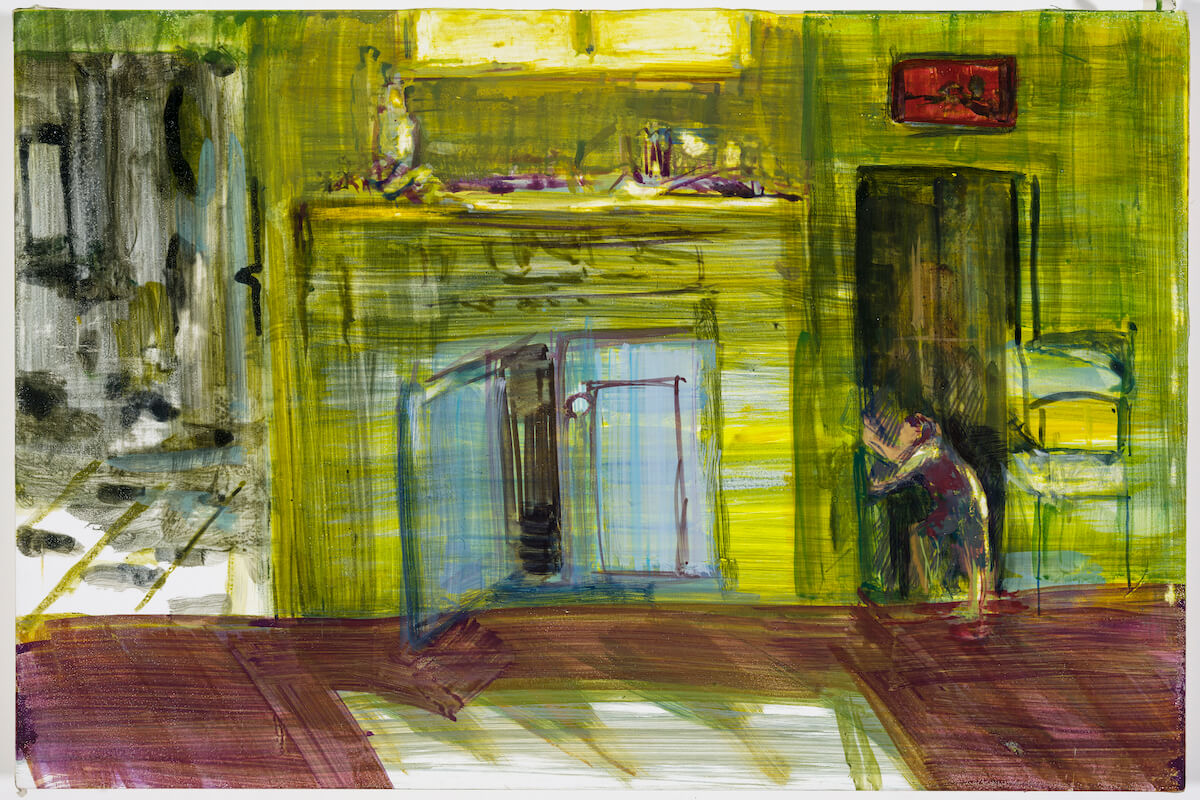
Susan G. Scott, LITTLE DOORWAY, 2022, egg tempera on panel, 9 x 11 inches / 22.86 x 27.94, catalogue # 22E25
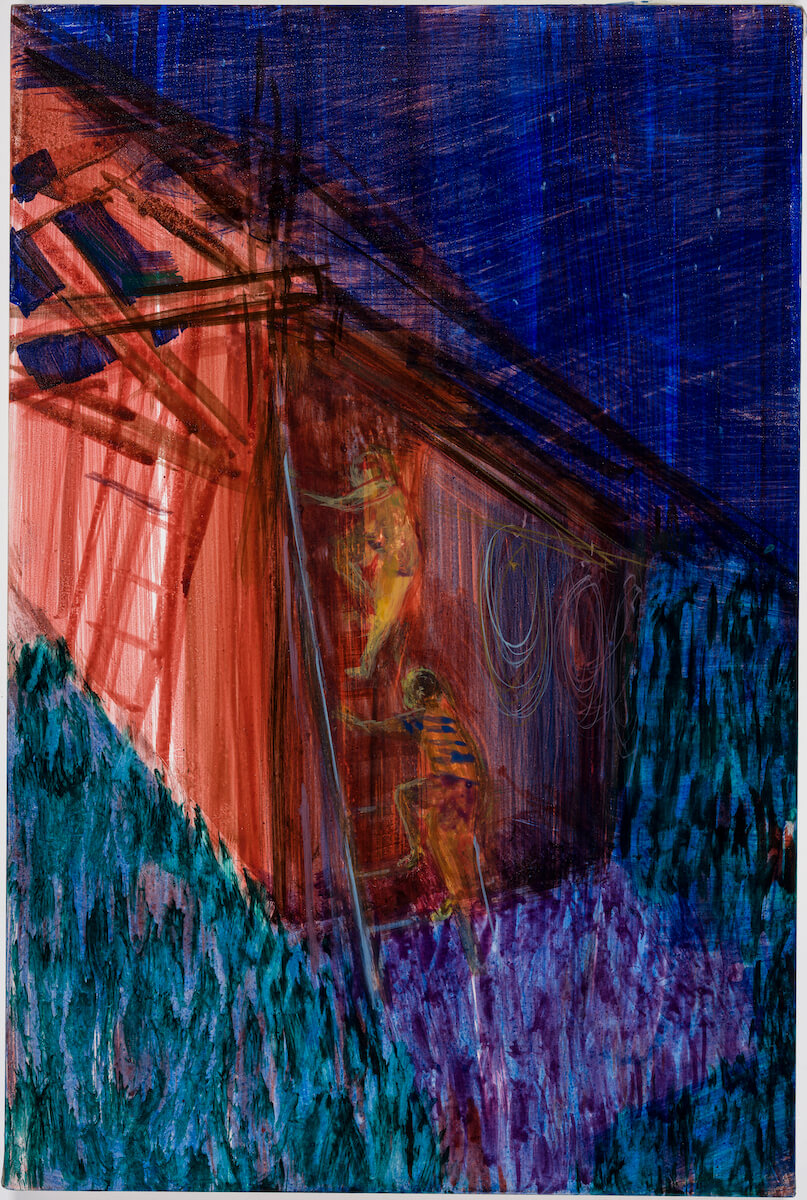
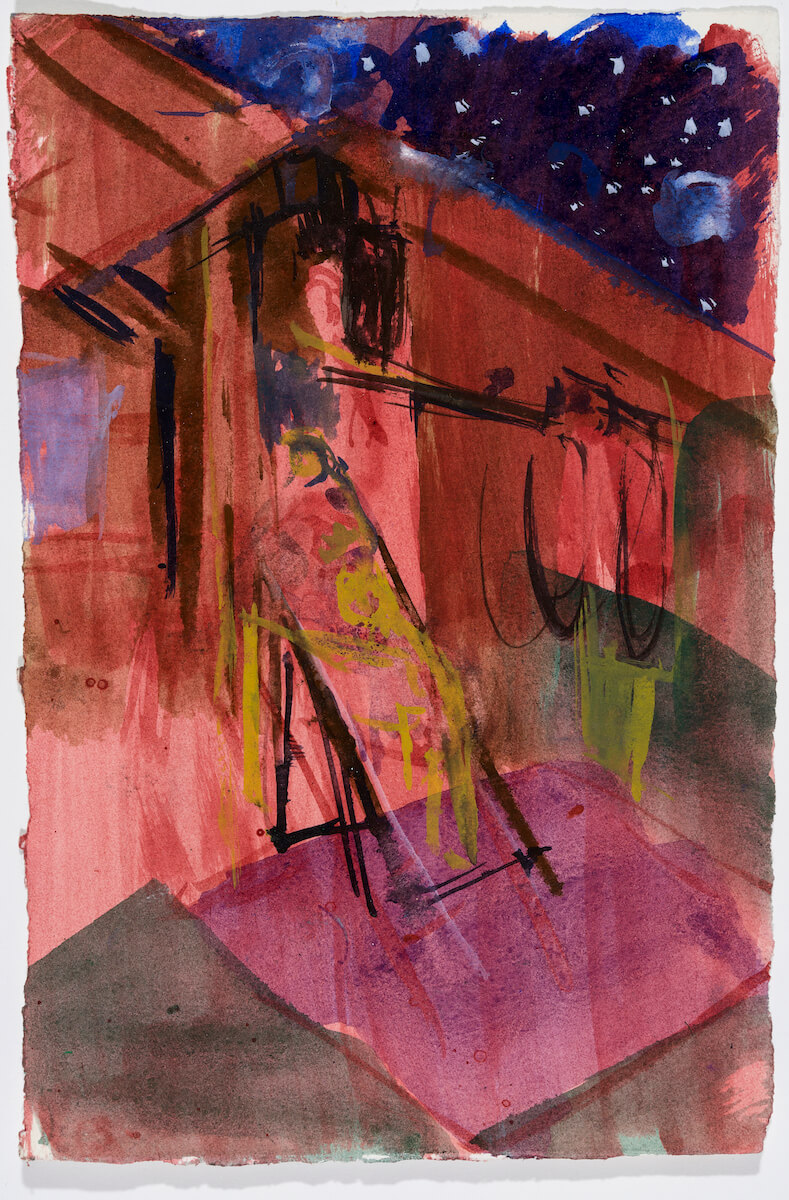
Susan G. Scott
ESCAPE, 2022
egg tempera on panel
18 x 12 inches / 45.72 x 30.48 cm
sketch for ESCAPE,
watercolour on paper
11 x 8 inches / 27.94 x 20.32 cm
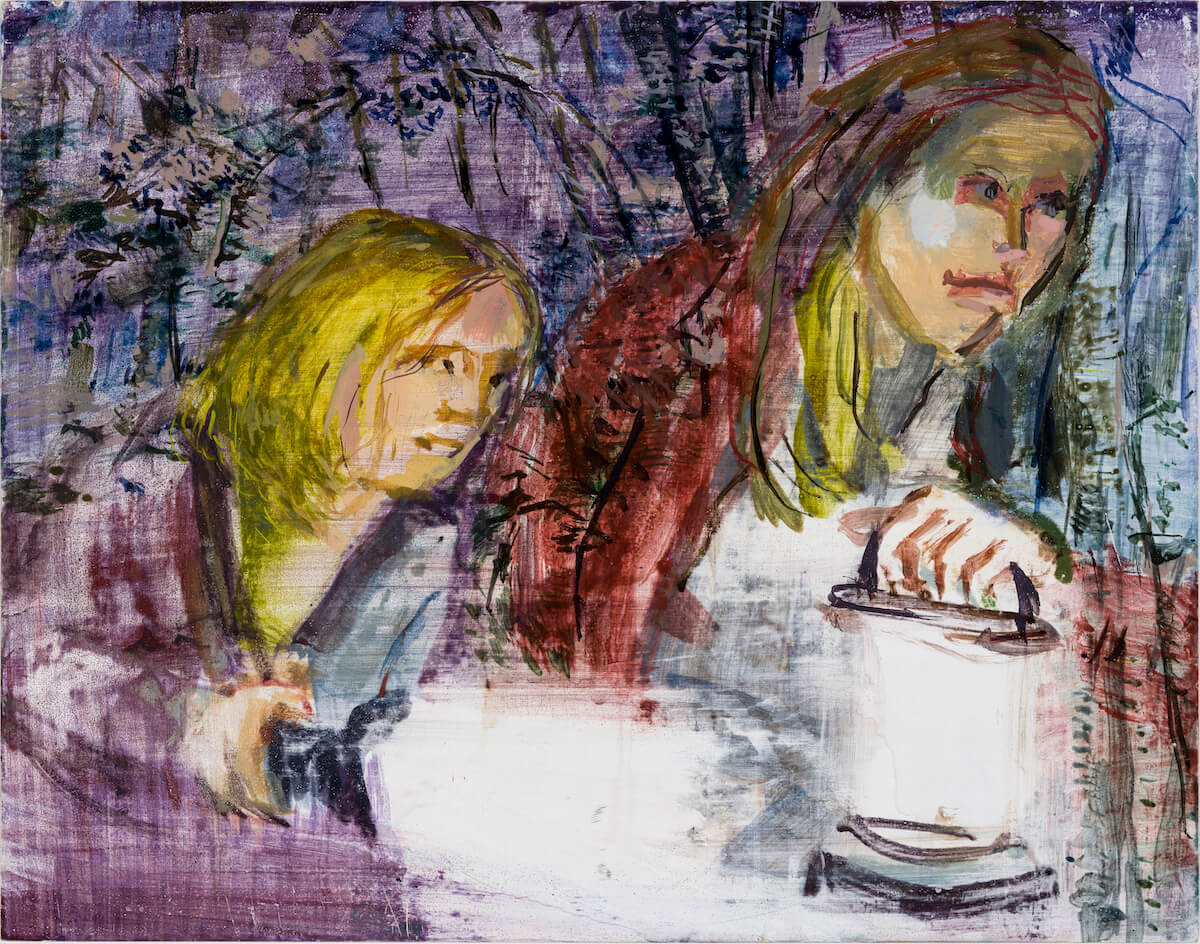
Susan G. Scott
LIGHTING THE WAY, 2022
egg tempera on panel
11 x 14 inches
27.94 x 35.56 cm
WOODEN PANELS
The wooden panels were cradled so that they don’t warp. They are first sanded down lightly, then sealed with gelatin.
Each panel has 5 to 8 thin layers of gesso ( The homemade gesso is a mixture of gelatin and chalk powder ). The panels were then sanded : first roughly to take off the bigger inconsistencies, then again with a very fine sandpaper for a smoother finish.
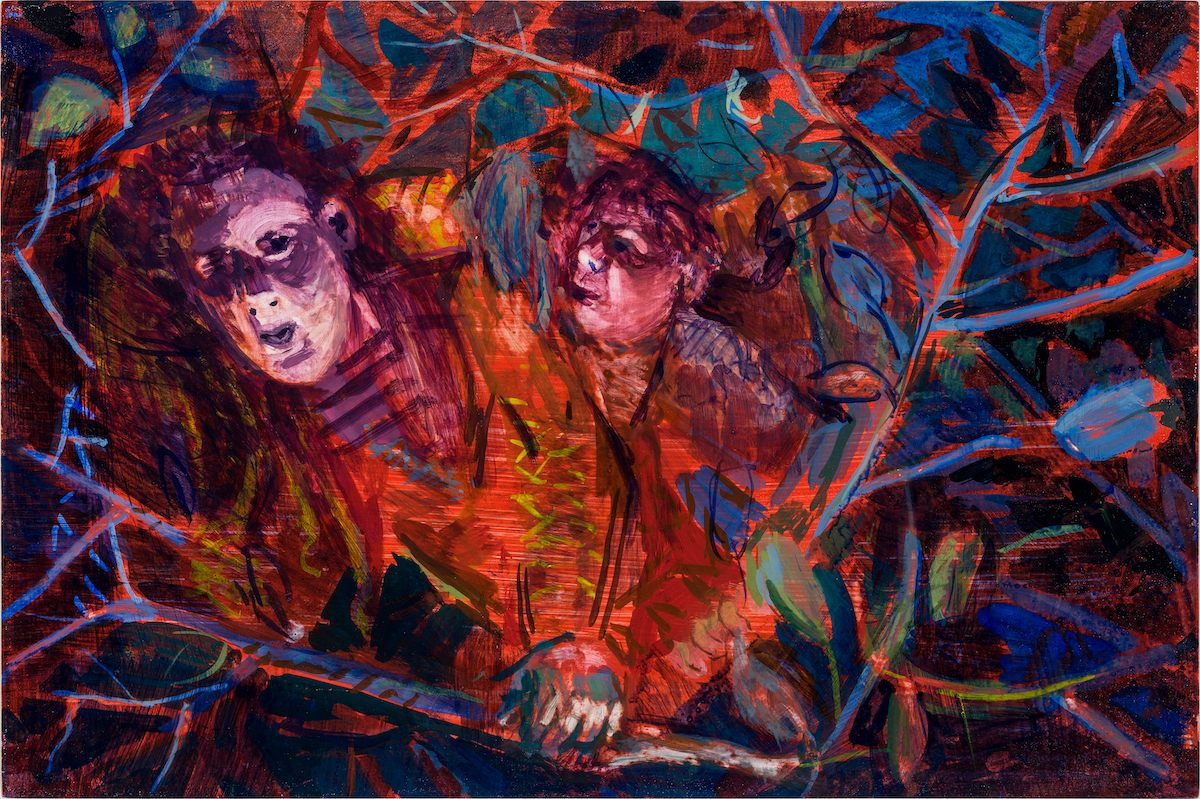
Susan G. Scott, UNDERBRUSH, 2022
egg tempera on panel, 12 x 18 inches / 30.48 x 45.72 cm
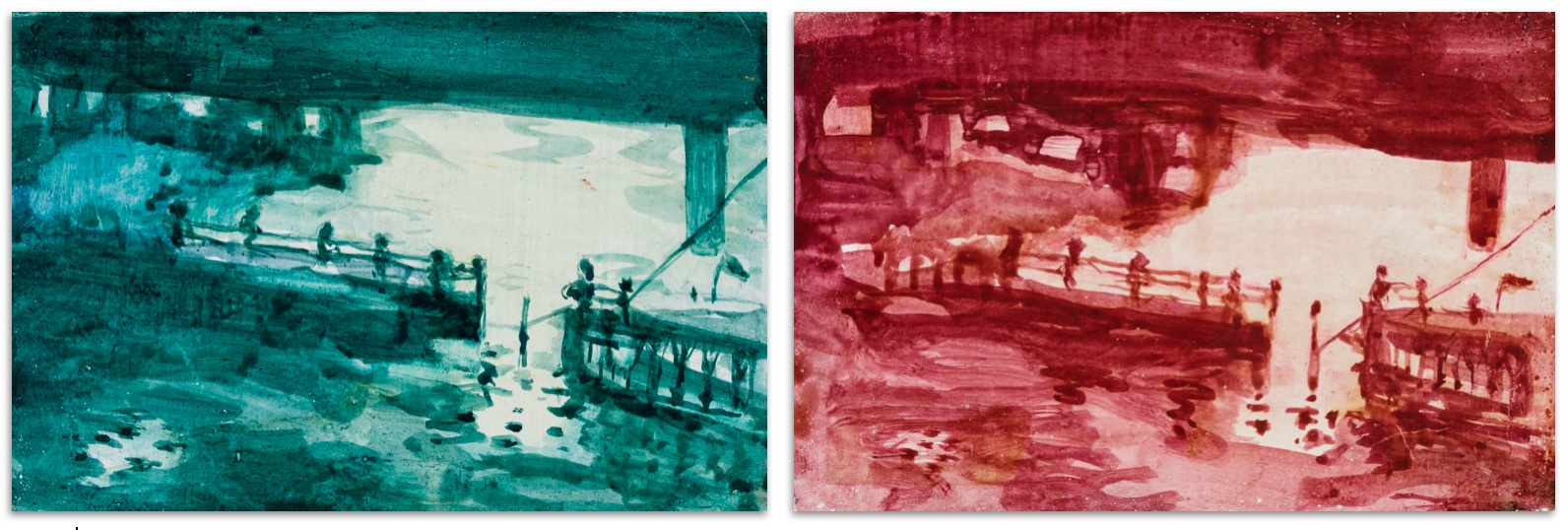
Susan G. Scott, NIGHT DOCKS (RED_GREEN) 2022
egg tempera on panel, 4 x 12 inches total / 10 x 30 cm
Susan g. Scott, TRACKING DAYLIGHT, 2022
egg tempera on panel, 11 x 9 inches / 27.94 x 22.86 cm
The surface is unlike any other painting-surface using commercially prepared gesso. It is very absorbent, fragile, incredibly smooth, and does not yellow.
Footnotes
1 Meilan Solly, “The Genre-Bending, Death-Defying Triumph of Charlotte Salomon’s Art,” November 15, 2019, Smithsonian Magazine.
link – smithsonianmag.com >
2 Altoon Sultan, “The Luminous Brush: painting with egg tempera”, publisher: Watson-Guptill, 1999 “complete with step-by-step photography, the book elucidates all stages of preparation, development, and completion of egg tempera paintings. Formal issues such as the depiction of light, colour, form, and detail are discussed. The book is available on line here >
3 in its original and most general sense tempera refers to a paint binder (in the sense of “tempering,” or modifying), and it was only more recently, and largely because of its use in association with medieval and early Italian paintings, that it took on a specific meaning of the “egg tempera” binder typically used in such works. With reference to mummy portraits, however, the descriptor carries the broader implication of a water-based binder, which may include egg, plant gum, or animal glue. While some interpretations of the “tempera” mummy portraits assume an egg medium, likely from conflation with Italian painting methods, recent research has revealed that, more often than not, those examples not painted with beeswax are made with animal glue.
https://www.getty.edu/publications/mummyportraits/part-one/1/
4 Brecoulaki, Hariclia, Caroline Zaitoun, Sharon R. Stocker, Jack L. Davis, Andreas G. Karydas, Maria Perla Colombini, and Ugo Bartolucci. “An Archer from the Palace of Nestor: A New Wall-Painting Fragment in the Chora Museum.” Hesperia: The Journal of the American School of Classical Studies at Athens 77, no. 3 (2008): 363–97. http:// www.jstor.org/stable/40205755.
5 Photography History Facts : camera obscura – link >
6 Ranquet, O., Duce, C., Bramanti, E. et al. A holistic view on the role of egg yolk in Old Masters’ oil paints. Nat Commun 14, 1534 (2023). https://doi.org/10.1038/s41467-023-36859-5
7 Theresa Machemer, See ‘The Last Supper’ in a New High-Resolution Scan Online :
Based on a copy made by Leonardo da Vinci’s pupils, the image will be useful to scholars and the public alike Smithsonian Magazine, June 22, 2020, https://www.smithsonianmag.com/smart-news/see-last-supper-new-high- resolution-scan-online-180975153/
8 Henry Adams, “Wyeth’s World : In the wake of his death, controversy still surrounds painter Andrew Wyeth’s stature as a major American artist,” The Smithsonian Magazine, June 2006
https://www.smithsonianmag.com/arts-culture/wyeths-world-117907877/
9 Ranquet, O., Duce, C., Bramanti, E. et al. A holistic view on the role of egg yolk in Old Masters’ oil paints. Nat Commun 14, 1534 (2023). https://doi.org/10.1038/s41467-023-36859-5
10 Radding, Kelly Leahy. “Ingredients For Inspiration.” The Botanical Artist, vol. 23, no. 1, 2017, pp. 20–23. JSTOR, https://www.jstor.org/stable/48502750. Accessed 23 Apr. 2023.
11 Fig water was once preferred to vinegar. “Painting in Tempera.” The Crayon, vol. 6, no. 3, 1859, pp. 81–84. JSTOR, http://www.jstor.org/stable/25527876. Accessed 24 Apr. 2023.
12 https://www.artcons.udel.edu/mitra/forums/question?QID=761#:~:text=I%20recommend%20a%20ratio%20of,wine%20(I%20prefer%20water).
13 Oil of Spike Lavender is a solvent distilled from the Lavandula spica variety of lavender. It is a strong enough solvent to fully dissolve resins and mix well with oils to make mediums.
14 Jo Marchant, “Document Detectives Use Smudges and Bloodstains to Investigate the Past: Proteins left behind on historic artifacts are revealing centuries-old secrets,” The Smithsonian Magazine, November-December 2021
https://www.smithsonianmag.com/history/document-detectives-use-smudges-bloodstains-investigate-past-180980986/
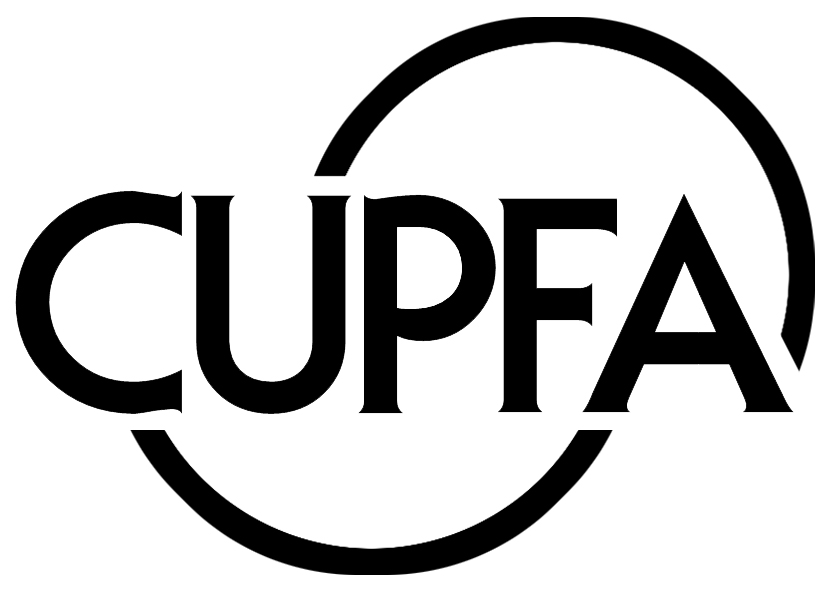
This step by step guide to the use and history of Egg Tempera was made possible through a grant from the Concordia University Part-Time Faculty Association.
